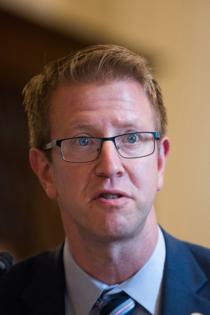'Eye-opening, to say the least': Lack of House continuity plan vexes Modernization panel
Published in News & Features
WASHINGTON — The second apparent attempt on former President Donald Trump’s life in as many months has brought renewed focus on the threat of political violence and its potential impact on American institutions. And again, Rep. Derek Kilmer is sounding the alarm: The House is not prepared.
“In this role, I often ask my constituents, ‘What keeps you up at night?’” the Washington Democrat said Wednesday at a hearing of the House Administration Modernization Subcommittee. “One that certainly keeps me up at night is political violence and Congress’ vulnerability to it.”
Kilmer, who is not seeking reelection, is referring specifically to a mass casualty event that could render the House nonfunctional.
While the Senate allows vacancies to be filled by appointment on an interim basis, the Constitution requires open House seats to be filled via special election, which can take months. In the wake of the Sept. 11, 2001, attacks, a law was enacted requiring states to hold special elections within 49 days of a mass casualty event that leaves more than 100 House vacancies.
But Kilmer has repeatedly expressed concern that states lack the ability to meet that requirement. Those concerns were borne out by a preliminary report conducted by the Government Accountability Office that Modernization Subcommittee Chair Stephanie Bice called “eye-opening, to say the least.”
Fifteen of 27 state election officials who responded to a survey conducted by the GAO said they were unaware of the federal law aimed at expediting the process to fill vacancies after a mass casualty. And out of all 50 states, just nine “have laws for holding special elections to fill House vacancies that adopt aspects of the federal law, such as those related to the 49-day time frame,” Rebecca Gambler, director of Homeland Security and Justice at the GAO, wrote in her testimony.
The answer to this widespread unpreparedness, Kilmer and a bipartisan group of lawmakers have decided, is a constitutional amendment to ensure the continuity of Congress.
“If Congress fails to enact a sufficient continuity plan, the American people will be left wondering why, in the world’s leading democracy, there was no plan to protect our most sacred democratic institutions,” Kilmer said.
Kilmer’s proposal, introduced earlier this year, would ease some of the pressure on states to hold snap elections. Instead, it would require all incoming members of the House to submit a list of at least five possible successors. Within 10 days of a member dying while in office, the governor from the lawmaker’s state would select one from the list to serve until a special election for a permanent replacement could be held.
The legislation has some bipartisan support, but faces an uphill climb. Constitutional amendments require a two-thirds vote from each congressional chamber and ratification from three-fourths of state legislatures. And while it’s common for members to introduce constitutional amendments, largely as messaging tools, the vast majority fizzle. The last amendment to the Constitution was adopted in 1992.
Bice, citing a recent Congressional Research Service report, said more than 40 constitutional amendments on the subject of continuity have been introduced since 1945, and none have made it far.
“This isn’t to say that we shouldn’t consider it, but I think it makes sense to also consider what we can do in the near-term to help safeguard continuity,” the Oklahoma Republican said.
Ohio Republican Rep. Brad Wenstrup, who co-sponsored Kilmer’s measure, testified on Wednesday about his experience administering emergency care to then-Majority Whip Steve Scalise in the 2017 congressional baseball practice shooting. Wenstrup, along with Kilmer, has argued the current system for filling vacancies in the House creates an incentive for political violence.
“A violent domestic terrorist attempted to assassinate Republican members of Congress. … He decided to use assassination as a tool for political change. He wanted to wipe out the Republican majority and change the balance of power in our Congress,” Wenstrup said. “Let’s take that opportunity away.”
_____
©2024 CQ-Roll Call, Inc., All Rights Reserved. Visit cqrollcall.com. Distributed by Tribune Content Agency, LLC.







Comments